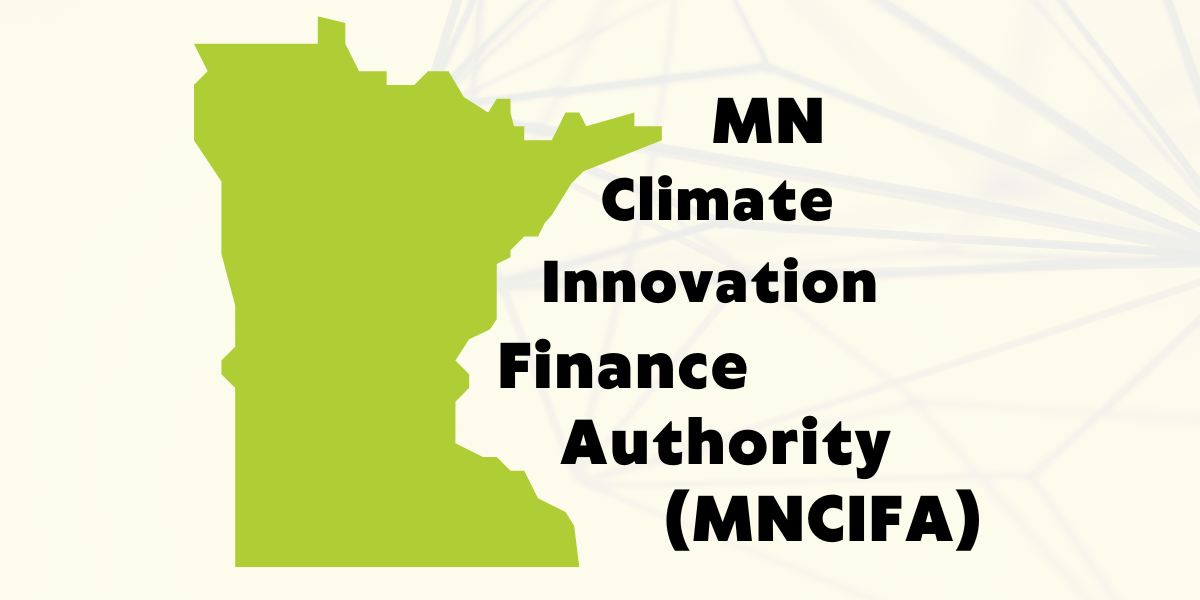Introducing the MN Climate Innovation Finance Authority
Rep. Emma Greenman and Sen. Tou Xiong have introduced a bill (HF2336/SF2301) to establish the Minnesota Climate Innovation Finance Authority (MnCIFA). If enacted, the MnCIFA will bridge financing gaps in clean energy and is run by the state government.
We are so excited to have gotten to this point and look forward to making this innovative finance tool a reality in Minnesota!
Now is the time for Minnesota to create and fund a CIFA to:
- Fill gaps with innovative financing tools that drive public purpose outcomes, not profits.
- Bring the transition to scale across Minnesota. Now is the time. With federal funding soon becoming available and a significant infusion of one-time surplus funds, we need to multiply the impact of one-time surplus dollars over the next 10 years and beyond.
- Provide regional offices around the state to offer a one-stop shop of technical and financial assistance, which will:
- provide individuals with everything they need to succeed in a project;
- partner with organizations such as county housing agencies to determine needs and plan and bring innovation to a neighborhood, community, business district, etc.; and
- fund community non-profits in every region to help do this work.
- Take advantage of federal Inflation Act Reduction funds.
The MnCIFA aims to reduce the upfront and total costs of the project for otherwise underserved communities using financial tools like:
- Inclusive Financing models (Pay as You Save), which orient the evaluation of an idea to the cash flow of the project itself, as opposed to focusing on the “credit-worthiness” of the “borrower.”
- Community ownership models, which proactively encourage shared systems like community solar, district ground-source heating and cooling, micro-grids, or other innovative business models that provide shared infrastructure benefiting many, independent of whether they own property or have access to capital.
- Traditional, but-better financial instruments, such as:
- direct lending
- co-investments that use public funds with private financier’s investment
- reduced risk options (e.g., loan loss reserves or guarantees)
- aggregating projects that may be smaller or geographically diverse
Take Action
Contact your legislator and ask them to support the establishment of the MnCIFA.
Fill out this form to tell us about your community and what project ideas this financing can make a reality. We will use these ideas in our outreach to legislators as to why this bill is important across Minnesota.
FAQs
Why does Minnesota need the MnCIFA?
Traditional funding options have huge equity barriers. If you have poor credit or insufficient starting capital, you often can’t get the funding needed for clean energy and sustainability projects. The MnCIFA will open up funding for underserved individuals and communities and will help more families, cities, and schools reduce their energy costs and carbon footprint.
The Federal government has passed multiple laws that put funding for these entities. States must create an entity to leverage federal dollars and private funds.
What is in the MnCIFA bill?
The proposal appropriates $45 million from the general fund for working capital and initial project investment to the MnCIFA. The MnCIFA positions Minnesota to maximize federal IRA green financing funds via competitive grants, with federal funds potential depending on final application requirements.
The MnCIFA has a similar structure and purpose to the other “green banks” established in 17 states and Washington D.C. Currently, 23 green finance authorities in states across the U.S. have turned $2 billion in public funds into $9 billion in green investment. Leveraging private investment means a state can do more.
How could Minnesotans benefit from this finance tool?
Current private investment activity for efficiency and renewables are a great start, but they don’t achieve the scale, meet all of the needs, or incentivize the quick adoption of better building standards in the way that a Climate Innovation Finance Authority could.
What potential gaps could the MnCIFA fill?
- Community-wide projects like geothermal or district heating and cooling, community solar, or microgrids that require significant coordination and pre-design.
- Lower- to moderate-income households and businesses that are perceived as riskier borrowers or otherwise don’t currently meet the requirements of private lenders. Without upfront capital to take advantage of tax rebates, many people will be left out of opportunities to choose renewables and save money.
- Agricultural Sector: Farms, strapped for time and people power, find it difficult to navigate funding and find technical assistance. New crops need funding to get through the “Commercialization Valley of Death.”
- Smaller KW projects: Because of increased costs per transaction, banks prefer to lend to larger projects, often leaving smaller projects unfunded.
- Influencing Building Standards: Public investment of sufficient scale and capacity, when tied to zero-emission building standards, can help drive markets towards better outcomes (for example, affordable housing with extremely low energy bills).
How can I learn more?
Watch the recording of our Minnesota Green Bank study circle from February 1, 2023.

